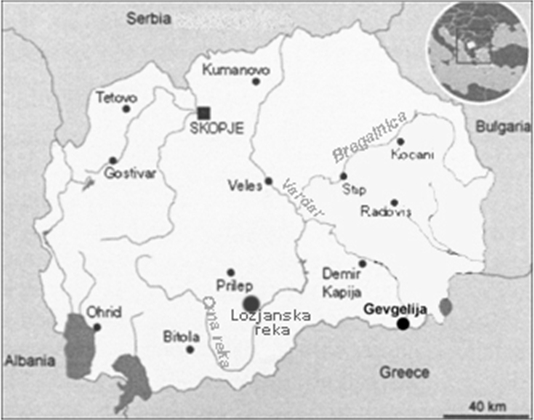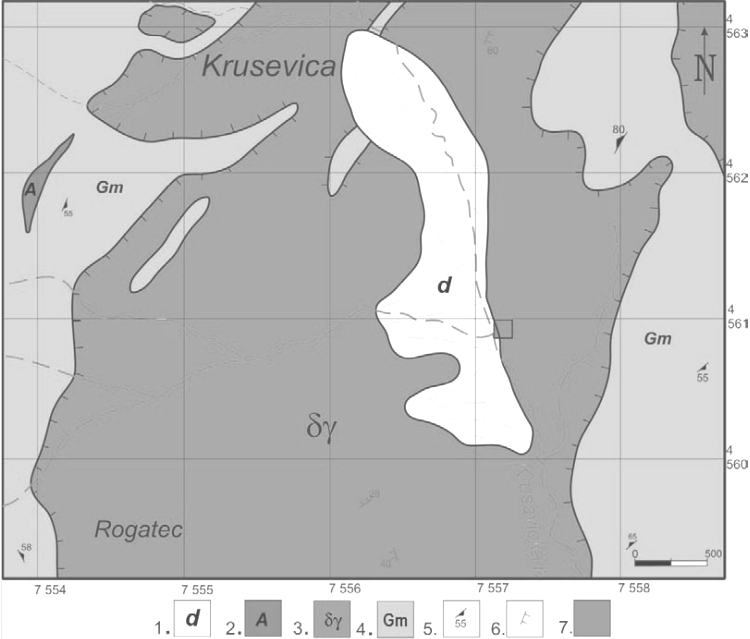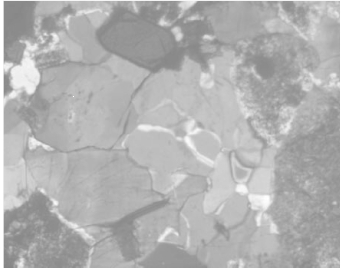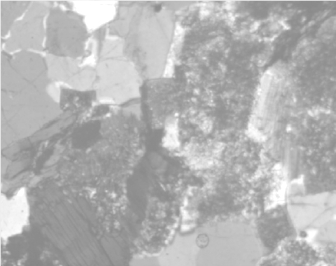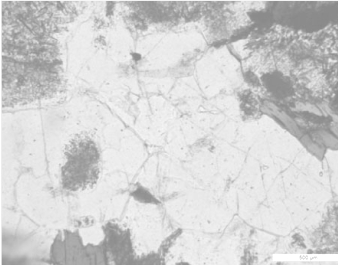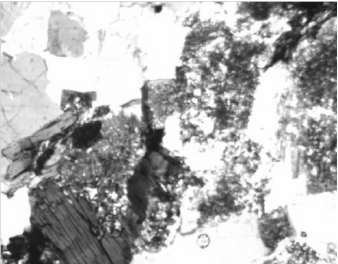PHYSICAL-MECHANICAL AND MINERALOGICAL-PETROGRAPHICAL CHARACTERISTICS OF THE GRANODIORITE OF “LOZJANSKA REKA”, VILLAGE OF KRUSEVICA (WESTERN MACEDONIA)
Spasovski O.1 Spasovski D.2
1Faculty of Natural and Technical Sciences, “Goce Delčev” University, Goce Delčev 89, MK-2000, Štip, Republic of Macedonia
2 Netcetera DOOEL, Skopje
PHYSICAL-MECHANICAL AND MINERALOGICAL-PETROGRAPHICAL CHARACTERISTICS OF THE GRANODIORITE OF “LOZJANSKA REKA”, VILLAGE OF KRUSEVICA (WESTERN MACEDONIA)
Abstract
The granodiorite of the Lozjanska Reka, western Macedonia, has been examined in order to determine the possibility to be used as an architectural stone. The samples were taken from the surface parts, and the results from their physical and mechanical examination have shown that rock mass itself satisfies all requirements form the use as architectural stone according to the state standards of R. Macedonia. Also the quality of the stone is greater in the deeper parts of the terrain where the influences from the outside have a very small effect. This stone does not have highly decorative features but it has a very fine grained structure which has a positive effect for the technical characteristics and for the being a subject for processing.
Keywords: granodiorite; Lozjanska Reka; architectural stone; mineralogic-petrographic composition; physical-mechanical characteristics.
IntroductionThe granodiorite of Lozjanska Reka is located about 6.0 km north-west from the Čanište village and about 0.5 km south-east from the village of Kruševica, in the series of gneisses which has been broken through with granite and granodiorite as part of the metamorphic complex of the Pelagon (Fig. 1). This area is geographically close to Selečka Mountain. The largest water artery in this part of the terrain is Čaniška Reka which has Lozjanska Reka, Kruševička Reka and Kosovska Reka as its confluents. In the past period, up to now, in search of good quality granite, many other regions have been researched on many occasions in the area of Mariovo, but no significant results have been received. Stojanov (1958, 1960, 1968 and 1974) has researched these terrains and distinguished many varieties of gneisses, mica schists, amphibolite and granitoid rocks. Some of the scientists stated some conclusions which concern the entire Pelagon and believes that in the beginning of the Algonquian orogenic movements a progressive metamorphosis has been done in the lower Precambrian complex and towards the end of the orogenic movements, granodiorit-adamelite masses have taken root.
Fig. 1 - Map of the R. Macedonia with position the locality “Lozjanska Reka”
In the period of making the Basic Geologic Map of SFRY the authors of the leave Vitolište (Dumurdžanov, Hristov, 1976a, 1976b) and Prilep (Rakičević, Stojanov, Arsovski, 1965a, 1965b) processed the leave content of the rocks of the leave Vitolište where the granodiorite Lozjanska Reka belongs.
Dumurdžanov (1985) explores the granitoids in details and concludes that they are mainly represented with granodiorite (70%) and quartzdiorite (20%), and less with quartz monocytes and granites.
MethodologyThe location Lozjanska River is explored using terrain and laboratorical explorations. The terrain explorations have provided the distinguished insight of the terrain, familiarization with its geological and structural-techtonic characteristics, as well as the collecting of representative samples from the granodiorite for defining their chemical and mineralogical composition, structural-textural and physical-mechanical characteristics.
The mineralogic-petrographic research have been done at the Faculty of Natural and Technical Sciences in Štip, while the chemical content of the granodiorite of the determined in the chemical laboratory of the Faculty of Natural and Technical Sciences with the instrument AES-ICP. The research of the physical-chemical characteristics was performed in the laboratory at the Faculty of Civil Engineering in Skopje. The examinations were performed during 2010. Because the rock masses are not well disposed, the samples were taken from the surface of the terrain. As a consequence, in the samples are some cracks that result from the great influence of the atmosphere. However, the examinations of the samples have shown credible values of their physical-mechanical characteristics. It is certain that the samples from the greater depths would give much better results.
Geologic featuresIn the geologic structure of the area that is included in our observation and research there are three types of rocks that included: muscovite gneisses, granodiorite, amphibolite and deluvial sediments (Fig. 2). The muscovite gneisses are outspread in the northern and north-eastern part of the researched area. They are characterized with grey colour with glittering radiance from the leaves of muscovite which can clearly be noticed. They are characterized with slightly distinguished parallel schistosity texture. The structure of the gneisses is grano-lepidoblastic with slightly distinguished striped texture. The main minerals in the rock are: quartz, feldspar and mica. The participation of salic and femic minerals is approximately equal in quantity, i.e. the salic are slightly more present. The quartz is found in xenomorphic crystals as well as in feldspars. The feldspar is K-feldspar – orthoclase, plagioclase. The orthoclase is fairly clayed while the plagioclase is more strongly clayed. The plagioclase is albite to intermediate plagioclase. It is rare to find some larger xenomorphic crystals of orthoclase, as porphyroblastic.
The mica is represented with muscovite and biotite. The secondary minerals are the epidote, rarely granite and mining mineral in irregular shapes. The epidote is quite common in long crystals and is regularly associated with mica lines. The apatite and the zircon are accessory minerals. Amphibolite appear as relatively sharply distinguished concordant stripes or irregular bodies. These rocks vary from light to dark-green, minisculeto largely granular, mostly schistified, rarely massive. The main minerals present with in the mare amphibol, oligoclase, andesine, less present are albite, oligoclase and epidote, while the granate, zoisite, biotite, diposide, titanite, quartz and rutile vary with their presence. They are often presenting minor quantities, locally they are present as important minerals.
Fig. 2 - Geological map of the locality “Lozjanska Reka”
1.deluvial sediments, 2. amphibolite, 3. granodiorite, 4. muscovite gneisses, 5. elements of foliation, 6. elements of fissures, 7. research area
Based on the structural-textural characteristics and the mineralogical composition, there are two basic varieties with in the granodiorites including porfirical granodiorites and massive to medium to largely granular granodiorites. Based on the microscopical exploration, significant varieties within the mineralogical composition of the grandiorites is seen, especially within the massive type. Porphyroidical grandiorites are grey, largely granular rocks with prophyric structure and massive texture.
They are comprised of plagioclases, K-feldspar, quartz and biotite as main minerals, and titanite, granite, apatite and zircone as a side minerals. As a result of the secondary changes the chlorite, epidote, zoisite, sericite, kaolin and limonite matter are present. The massive granodiorites are not completely homogenous in it’s composition and there are significant varieties regarding the presence of certain minerals. In distinguishhed partitions the K-feldspar are more present and the rocks represent quartz monocytes or granites and on some occasions when they are present less then 5% the same cross over to quartz diorite. The massive granodiorites are grey to dark-grey, medium to largely granular. They are comprised of plagioclase, caliumfeldspate, quartz and biotite as main minerals, and apatite, titanite, amphibole, zircone, granite and magnetite as a lesser frequent minerals.
Secondary there are the epidote, zoisite, sericite, аlbite, chlorite, kaolin and limonite matter. The deluvial sediments are largely dispersed on the Selečka Mountain in the valley of the Kruševička Reka (Figure 2). The sediments represent the material from the granodiorite sand metamorphic rocks.
Petrographic-mineralogic characteristicsThere were some representative samples from the locality Lozjanska Reka selected for the mineralogic-petrographic examinations. 5 petrographic samples were examined with a polarized microscope with transmitted light, brand Leitz, Wetzlar, Germany. The mineralogic-petrographic examinations were performed at the Faculty of Natural and Technical Sciences, Institute for Geology, by the author of the paper. The granodiorite is characterized with medium to large grained structure and light grey-pink colour equally present throughout the entire sample (Figs. 3 and 4). The mineral grains are most common with the size of 4 to 5 mm, but there are also grains with the size of 1 cm. On a microscope it can be seen that they have hypodiomorphic grain structure (Figs. 5 and 6). The main minerals are: quartz, plagioclase, orthoclase and biotite. The plagioclase is clearly defined and is present as hypodiomorphic and irregular crystals, lengthened and wider rectangular shapes.
The plagioclase is strongly metamorphized and the products are the epidote and the coesite, but also there is a zonal allotment and intense alterization of the plagioclase in the middle parts. The plagioclase is more present that the orthoclase and the quartz. According to the altered products and the weak zonal allotment, the plagioclase is intermediate, i.e. andesine-labradorite weakly acid. The orthoclase is xenomorphic, fresh and poorly clayed, and regularly poikilitic incorporates smaller crystals in the plagioclase and the biotite.
The orthoclase is weakly microclinised at separate crystals. Тhе biotite is present in large square leaves and smaller rectangular leaves outspread – separate and in places grouped in small clumps. It has clear brown pleochroism. The biotite contains idiomorphic spires-microlites on the zoisite, and on the edges there are also crystals of the epidote and the apatite. The quartz is found in the interspace with smaller xenomorphic grains. It is slightly undulose darkened which points to the fact that it has slight mechanic deformations. Allanite and zircon are accessory minerals. The rock is quite strong, with slight cracks on it, i.e. with slight mechanic deformations which can be seen with the slightly distinguished darkening of the quartz as well as the slightly present micro-cracks at the orthoclase.
Quartzdiorite is characterized with dark greygreenish color, medium grained structure with a particular slightly distinguished oriented striped texture. The hard rock is with massive texture. The rock is constituted of quartz, amphibole, biotite, plagioclase and not so often K-feldspar, which are the main minerals. When the quantity is concerned, the coloured minerals (amphibole, biotite and epidote) are more common than the salic minerals. Probably, the rock is additionally metasomatic feldspatized. Na-feldspar is present in large irregular crystals which include many inclusions and crystals from epidote – zoisite and amphibole. With separate albites, some polysynthetic lamellas can be seen. K-feldspar is less present and mostly in a shape of xenomorphic crystals. The quartz is present in xenomorphic grains in the interspace of the remaining minerals. It is clearly evident that the coloured minerals are present with irregular shape of the crystals with different orientation, i.e. the crystals of the amphibole and the biotite are presented vertically and sidelong with a given slightly distinguished oriented texture (Figs. 3 and 4). This points out that the rock apart from the metasomatic processes has gone under metamorphism from regional retrograde metamorphism.
Fig. 3 - Medium to large grained structure of the granodiorite. Crossed nicols, magnified 50
Fig. 4 - Medium to large grained structure of the granodiorite. Parallel nicols, magnified 50×
The amphibole is found in big square crystals and with little leave-like crystals, stretched about shapes and densely mixed with biotite and big crystals of the epidote. The amphibole is weakly alkaline hornblende. The biotite is also present in larger and smaller leaves with different orientation. The secondary minerals are the allanite, zoisite and mining mineral (oxide mineral), and the apatite and the zircon are accessory minerals.
Striped muscovite gneiss has grey color with glittering radiance from the leaves of muscovite which can clearly be noticed. They are characterized with medium grained structure with slightly distinguished parallel schistose texture. The regular pattern of minerals throughout the sample can be seen.
Fig. 5 - Hypodiomorphic grain structure of the ranodiorite. Crossed nicols, magnified 50
Fig. 6 - Hypodiomorphic grain structure of the ranodiorite. Parallel nicols, magnified 50
With a microscope the grano-lepidoblastic structure with slightly distinguished striped texture can be observed.
The main minerals in the rock are: quartz, feldspar and mica. The participation of salic and femic minerals is approximately equal in quantity, i.e. the salic are slightly more present.
The quartz is found in xenomorphic crystals as well as in feldspars. The feldspar is K-feldspar – orthoclase and plagioclase so the plagioclase is more present. The orthoclase is fairly clayed while the plagioclase is more strongly clayed. The plagioclase is albite to intermediate plagioclase. Rarely are find some larger xenomorphic crystals of orthoclase.
The mica is represented with muscovite and biotite and they are found in not clearly distinguished lines. It is typical for the biotite that it is bleached – barytised, so it has a fairly weak brownish interference. There is an impression that it is muscovite with separated Fe-component with thicker irregular shapes at the leaves themselves. It is possible that it is mica-phengite. The secondary minerals are the epidote, orthite, rarely granite and mining mineral in irregular shapes. The epidote is quite common in long crystals and is regularly associated with mica lines. The apatite and the zircon are accessory minerals. It is a metamorphic rock which has pointed and not well defined striped texture. he quartz is darkening while the feldspar are with cracks and altered.
Chemical examinationsThe chemical characteristics of the granitoide rocks from the Lozjanska Reka locality, Kruševica, represent a contribution to the broadening of the knowledge for this massive on the territory of the Republic of Macedonia. This massif is evidently different from the surrounding rocks by its content, structural-tectonic features, color and the manner of its origination. Basically, granodiorite is characterized with homogeneous solid to compact texture, which locally turns to porphyroide. With such
arrangement and intergrowth of the mineral components, beige to greenish basic color spotted with biotite of black color is formed in the mineral aggregate.
For more detailed presentation of the chemical content of the granodiorites from the Lozjanska Reka locality, four representative samples were taken from the granodiorites and one sample from a light grey rock with great compactness.
The examinations of the taken samples were performed at the Faculty of Natural and Technical Sciences with the instrument AES-ICP. The chemical content of the analyzed samples are presented in Table 1.
Table 1 - Chemical composition of the granodiorites from the “Lozjanska Reka” locality (%)
| Components | Symbol of the sample | ||||||||
| Lz/1 | Lz/2 | Lz/3 | Lz/4 | Lz/5 | |||||
| SiO2 | 65.60 | 66.30 | 65.89 | 65.60 | 68.50 | ||||
| Al2O3 | 16.25 | 16.42 | 16.85 | 16.24 | 15.03 | ||||
| Fe2O3 | 2.41 | 2.21 | 2.65 | 2.38 | 3.14 | ||||
| MnO | 0.069 | 0.070 | 0.072 | 0.099 | 0.08 | ||||
| MgO | 0.68 | 0.72 | 0.74 | 0.41 | 0.86 | ||||
| CaO | 4.31 | 4.56 | 4.56 | 4.09 | 2,93 | ||||
| K2O | 4.78 | 4.75 | 4.92 | 4.94 | 4.29 | ||||
| Na2O | 3.70 | 3.71 | 3.75 | 3.58 | 3.99 | ||||
| TiO2 | 0.412 | 0.423 | 0.431 | 0.334 | 0.20 | ||||
| P2O5 | 0.21 | 0.19 | 0.23 | 0.11 | 0.17 | ||||
| LOI | 1.250 | 0.950 | 0.980 | 0.78 | 0.66 | ||||
| Total | 99.67 | 100.303 | 100.923 | 98.563 | 99.85 | ||||
| Ba (ppm) | 650 | 640 | 631 | 647 | 642 | ||||
| Sr (ppm) | 250 | 265 | 247 | 250 | 260 | ||||
| Y (ppm) | 22 | 26 | 27 | 24 | 25 | ||||
| Sc (ppm) | 7 | 7 | 7 | 7 | 7 | ||||
| Zr (ppm) | 237 | 242 | 251 | 240 | 242 | ||||
| Be (ppm) | 2 | 4 | 3 | 2 | 4 | ||||
| V (ppm) | 44 | 41 | 38 | 45 | 39 | ||||
From the table presented it can be stated that the analyzed samples are characterized with a constant chemical content which can be seen in the content of SiO2 which is in range of 65.60 to 68.50. From the analyzed samples it can be spotted that there is a slight increase of Al, Ca, K, Fe and Mg, but especially Al which is probably due to the additional secondary processes which the analyzed samples were influencedly. Analysis of trace elements (Table 1) indicate a significant presence of trace elements from the ranks of Ba, Sr, Zr and V.
Physical-mechanical characteristicsThe purpose of this research is to determine the physical-mechanical characteristics of the stone and to determine the eligibility of the material for its application in the civil engineering for the production of fractioned broken stone aggregate for concrete and asphalt compositions and for other applications in the trade in accordance with MKS standards.
The performed analyses are in accordance with the valid standards: МКS, B.B2.009, МКS B.B8.003, МКS Ѕ.Е9.021, МКS U.Е9.028, МКS ЅЕ4.014, МКS B.B8.045. The received results for the physical-mechanical characteristics of the granodiorite are presented in Table 2.
After the performed analysis of the received results it can be concluded that for a stone material of high strength to pressure, rock breakage, high resistance to destruction and scraping, low absorption of water, compact to high transmission mass and constant to the frost exposure.
According to the determined physical-mechanical characteristics, the examined stone from the rock of the village of Kruševica locality is a eligible stone and it can be applicable in various fields as well as in civil engineering, as the following:
– production of concrete mixtures,
– production of bitumen layer,
- production of road metal.
Table 2 - Results of the physical-mechanical characteristics
| No | Analysis | Method according to MKS | Unit | Symbol | Results from the analysis | Conditions for quality: BET.MKS B.B2.009 BNS/MKS U.E9.021/028 AB/MKS U.E9.028 |
| 1 | Compressive strength in dry conditions | B.B8.012 | MPa | σpmin σpmax σpsred | 146.30 185.40 171.90 | BET/min. (80;160) BHS/min (100) AB/min. (120;140;160) Buffer/min.(100;120) |
| 2 | Pressure strength in water satiation condition | B.B8.012 | MPa | σpmin σpmax σpsred | 116.20 146.20 134.60 | BET/min. (64;128) BHS/min (100) AB/min. (120;140;160) Buffer /min.(100;120) |
| 3 | Pressure strength after 25 frost cycles | B.B8.010 | MPa | σpmin σpmax σpsred | 104.60 161.80 142.40 | / |
| 4 | Water absorption | B.B8.010 | % (m/m) | U | 0.167 | BET/min. (1.0) AB/min. (0.75;1.0) Buffer /min.(1.0) |
| 5 | Resistance to destruction and scraping | B.B8.015 | cm3/50 cm2 | Ab | 8.40 | BET/min. (35.0) AB/min. (12.0;18.0;35.0) |
| 6 | Volume capacity with cavities and cracks | B.B8.032 | kg/m3 | gv | 2745 | (2000–3000) kg/m3 |
| 7 | Volume capacity without cavities and cracks | B.B8.032 | kg/m3 | gs | 2775 | (2000-3000) kg/m3 |
| 8 | Degree of density | B.B8.032 | % (mm)/ | G | 98.74 | / |
| 9 | Porosity | B.B8.032 | % (m/m) | P | 1.26 | / |
| 10 | Consistency to ice exposure | B.B8.001 | Damage and loss (g) | M | No loss of the weight, damage and cracks | BET/min. (5.0) AB/min. (5.0) Buffer /min.(10.0;12.0) |
Conclusion
The samples were taken from the surface parts of the terrain where the influences from the outside are quite intense. In the deeper layers of the ground, the rock mass is found as blocks and less affected by the atmospheric influence which enables a better quality. Based on the received results from the analyses it can be concluded that it can be used as an architectural stone.
The rock mass is medium-granular which makes the granodiorite from Lozjanska Reka to give valid the physical-mechanical characteristics and eligibility for processing (cutting, polishing, etc.). The absence of pyrite enables endurance from the influences from the atmosphere.
The weaknesses of this stone are the following: it has average decorative values, heterogeneous appearance. These rocks masses are almost an easy subject to erosion in the surface parts, but they have decorative possibilities in the deeper parts.
According to the mineral-petrographic composition, structural-textural characteristics the granodiorite is quite solid and can be widely used in the civil engineering primarily as architectural stone for production of tiles for interior and exterior use for tiling walls. The remaining part after the cutting can be used as technical stone for aggregate with different granulation for the use of concrete and asphalt mixtures, as well as for other building needs.
According to the mineral-petrographic content, structural-textural characteristics the amphibolites quartz-diorite can be widely used in the civil engineering. It can be used as architectural stone, as technical stone for stone blocks and separated aggregate for asphalt and concrete mixtures, as well as for other building needs.
Due to the great quantity of phyllo-silicates – micas it is expected the striped muscovite gneiss to have low strength characteristics and for that reason it is not recommended for use as technical stone. The feldspars are also significantly clayed so the stone would have weak resistance from the atmospheric influences. Generally the striped muscovite gneiss from its mineral-petrographic aspect and structural-textural characteristics is not suitable for building purposes. It can only be found useful as electro-insulation material where the mica content is requested.
With the received values for the mineralogicpetrographic features of the granodiorite from the Lozjanska Reka locality, it can be concluded that it satisfies all criteria for an architectural-building stone, even some parameters are even higher that the requested ones.
Литература
- Бариќ, Љ., 1940: Извештај о теренском раду у околини Прилепа. Год. Геол. Инст. Кр. Југ. за 1939 год. Београд.
- Буе, А., 1891: Геолошка скица Европске Турске. Додаток во Геолошких анала Балканског полуосторва 3. Београд.
- Цвијиќ, Ј., 1906: Основе за географију и геологију Македоније и Старе Србије. Посеб. Изд. С. А. Књ. I Београд.
- Цвијиќ, Ј., 1911:Основе за географију и геологију Македонија и Старе Србије, и тд. Књ. III, Београд.
- Думурџанов, Н., Христов, С., Павловски, Б., Иванова , В., 1976a: Толкувач за основна геолошка карта 1 : 100 000 за листот Витолиште – Кајмакчалан. Стр. Фонд на Геолошки завод Скопје. Стр. 60.
- Думурџанов, Н., Христов, С., 1976b: Толкувач за основна геолошка карта 1 : 100 000 за листот Витолиште. Стр. Фонд на Геолошки завод Скопје. Стр. 65.
- Думурџанов, Н., (1985): Петрогенетски карактеристики на високометаморфните и магматски карпи на централните и западните делови на Селечка Планина (СР. Македонија). Geologica Macedonica T II sv. 1. pp. 3-104, Штип.
- Мариќ. Љ., (1936): Проучавање кристаластих стена Кајмакчелана. Изв. о раду Геол. Инст. Кр. Југ. за 1935 год. Београд.
- Мариќ, Л., (1940): Петрографска и геолошка градња околине Прилепа и СИ од Прилепа у јужној Србији. Весн. Геол. Инст. Кр. Југ. књ. VIII Београд.
- Николов, Н., (1921): Цијанитот од Селечка Планина в Македонија. Труд. на Бугарското природоизпит, дружество, кн. IX Софија.
- Николов, Н., (1924): Белешки врху петрографијата и геологијата на Селечка Планина в Македонии. Год на Софис. Унив. Физ. Мат. Факултет кн. 3. Софија.
- Ракичевиќ, Т., Стојанов, Р., Арсовски, М., 1965a: Основна геолошка карта 1 : 100 000 лист Прилеп. Стр. Фонд на Геолошки завод Скопје.
- Ракичевиќ, Т., Стојанов, Р., Арсовски, М., 1965b: Толкувач за Основна геолошка карта 1 : 100 000 лист Прилеп. Стр. Фонд на Геолошки завод Скопје. Стр. 65.
- Stojanov, R., (1958):Претходни резултати од геолошките и петрографските истражувања на Слечка Планина. Трудови на Геолошкит завод на Република Македонија. Св. 6. Стр. 127-180.
- Stojanov, R., (1960): Претходни резултати од геолошките и петрографските истражувања на високо метаморфните стени од централниот дел на Пелагонскиот масив. Трудови на Геолошкиот завод на Република Македонија. Св. 7. Стр. 147-178.
- Стојанов, Р., 1968: Фенгити на Пелагонскиот масив. Трудови на Геолошкиот завод на Република Макдеонија. Св. 13.
- Стојанов, Р.,1974: Петролошки карактеристики на магматските и метаморфните стени од пошироката околина на Прилеп. (Македонија). Посенбно издание на трудови на Геолошки завод, бр. 4. Скопје.
- Тучан, Ф., (1926): Минералошко – петрографска проучавања у кристаластом масиву измеѓу Прилепа и Кајамкчалана. Гласн. Ск. Нуч. Др-ва. Књ. II, св. 1 и 2. Скопје.
References
- Bariḱ, Lj., 1940: Izveštaj o terenskom radu u okolini Prilepa. God. Geol. Inst. Kr. Jug. za 1939 god. Beograd.
- Bue, A., 1891: Geološka skica Evropske Turske. Dodatok vo Geoloških anala Balkanskog poluostorva 3. Beograd.
- Cvijiḱ, J., 1906: Osnove za geografiju i geologiju Makedonije i Stare Srbije. Poseb. Izd. S. A. Knj. I Beograd.
- Cvijiḱ, J., 1911:Osnove za geografiju i geologiju Makedonija i Stare Srbije, i td. Knj. III, Beograd.
- Dumurdžanov, N., Hristov, S., Pavlovski, B., Ivanova , V., 1976a: Tolkuvač za osnovna geološka karta 1 : 100 000 za listot Vitolište – Kajmakčalan. Str. Fond na Geološki zavod Skopje. Str. 60.
- Dumurdžanov, N., Hristov, S., 1976b: Tolkuvač za osnovna geološka karta 1 : 100 000 za listot Vitolište. Str. Fond na Geološki zavod Skopje. Str. 65.
- Dumurdžanov, N., (1985): Petrogenetski karakteristiki na visokometamorfnite i magmatski karpi na centralnite i zapadnite delovi na Selečka Planina (SR. Makedonija). Geologica Macedonica T II sv. 1. pp. 3-104, Štip.
- Mariḱ. Lj., (1936): Proučavanje kristalastih stena Kajmakčelana. Izv. o radu Geol. Inst. Kr. Jug. za 1935 god. Beograd.
- Mariḱ, L., (1940): Petrografska i geološka gradnja okoline Prilepa i SI od Prilepa u južnoj Srbiji. Vesn. Geol. Inst. Kr. Jug. knj. VIII Beograd.
- Nikolov, N., (1921): Cijanitot od Selečka Planina v Makedonija. Trud. na Bugarskoto prirodoizpit, družestvo, kn. IX Sofija.
- Nikolov, N., (1924): Beleški vrhu petrografijata i geologijata na Selečka Planina v Makedonii. God na Sofis. Univ. Fiz. Mat. Fakultet kn. 3. Sofija.
- Rakičeviḱ, T., Stojanov, R., Arsovski, M., 1965a: Osnovna geološka karta 1 : 100 000 list Prilep. Str. Fond na Geološki zavod Skopje.
- Rakičeviḱ, T., Stojanov, R., Arsovski, M., 1965b: Tolkuvač za Osnovna geološka karta 1 : 100 000 list Prilep. Str. Fond na Geološki zavod Skopje. Str. 65.
- Stojanov, R., (1958):Prethodni rezultati od geološkite i petrografskite istražuvanja na Slečka Planina. Trudovi na Geološkit zavod na Republika Makedonija. Sv. 6. Str. 127-180.
- Stojanov, R., (1960): Prethodni rezultati od geološkite i petrografskite istražuvanja na visoko metamorfnite steni od centralniot del na Pelagonskiot masiv. Trudovi na Geološkiot zavod na Republika Makedonija. Sv. 7. Str. 147-178.
- Stojanov, R., 1968: Fengiti na Pelagonskiot masiv. Trudovi na Geološkiot zavod na Republika Makdeonija. Sv. 13.
- Stojanov, R.,1974: Petrološki karakteristiki na magmatskite i metamorfnite steni od poširokata okolina na Prilep. (Makedonija). Posenbno izdanie na trudovi na Geološki zavod, br. 4. Skopje.
- Tučan, F., (1926): Mineraloško – petrografska proučavanja u kristalastom masivu izmeǵu Prilepa i Kajamkčalana. Glasn. Sk. Nuč. Dr-va. Knj. II, sv. 1 i 2. Skopje.

